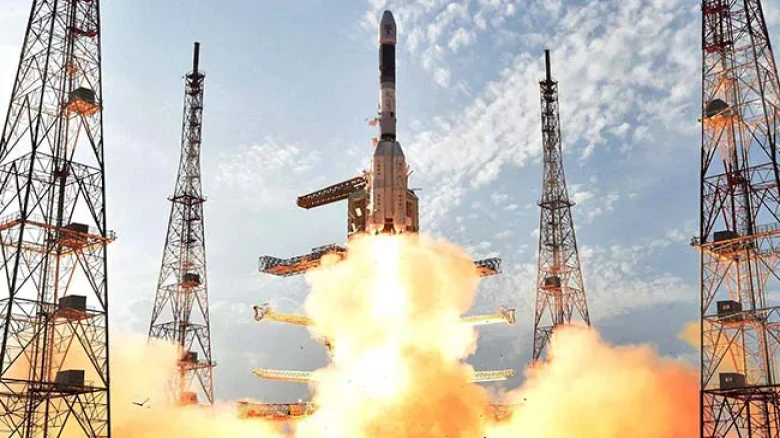The GSLV is a three-stage rocket with a liftoff mass of 420 tonnes that is 51.7 meters long, or roughly 25% the length of the Statue of Unity, which is 182 meters tall.
Digital Desk: India will launch its most recent weather satellite on Saturday using a rocket known as the "Naughty Boy" of the Indian space agency.
The former Indian Space Research Organization (ISRO) chairman called the Geosynchronous Satellite Launch Vehicle (GSLV) a "naughty boy" because the rocket has failed in six of its fifteen flights, or forty percent of the total. The GSLV is set to launch with the INSAT-3DS satellite from Sriharikota, Andhra Pradesh, at 5:35 p.m. on Saturday. The most recent GSLV launch, which took place on May 29, 2023, was successful; however, the launch on August 12, 2021, was unsuccessful.
On the other hand, the Launch Vehicle Mark-3, often known as the "Bahubali rocket," is the bigger relative of the GSLV and has only made seven flights with a 100% success rate. With only three failures in 60 missions, the Polar Satellite Launch Vehicle (PSLV), ISRO's workhorse rocket, boasts an impressive 95% success rate.
The GSLV is a three-stage rocket with a liftoff mass of 420 tonnes that is 51.7 meters long, or roughly 25% the length of the Statue of Unity, which is 182 meters tall. After a few more launches, ISRO intends to retire the rocket's cryogenic engine, which is produced in India.
In order to improve India's weather and climate monitoring services, a highly special and urgently needed satellite launch is scheduled for this Saturday. It is a third-generation improved dedicated meteorological satellite, known as INSAT-3DS. The satellite was constructed for approximately Rs 480 crore and has a weight of 2,274 kg. According to ISRO, the Ministry of Earth Sciences is totally funding it.
The Department of Space is only allowed to launch missions that have the full approval and endorsement of user agencies under Prime Minister Narendra Modi.
Improved Forecasts, Saving Lives
According to ISRO authorities, the purpose of the new weather monitoring satellite is to monitor land and ocean surfaces for improved meteorological observations and to forecast weather and warn of impending disasters. These aerial cameras have been used by India to assist its meteorological bureau in providing increasingly precise forecasts, which frequently result in life-saving actions.
Satellites tracking Indian weather have changed the game. As the secretary of the Ministry of Earth Sciences and a distinguished expert in atmospheric and ocean research, Dr. M. Ravichandran stated, "Satellites are truly the eyes in the sky that have helped India forecast cyclones with great precision."
"During the 1970s, cyclones that originated in the Bay of Bengal killed almost 300,000 people. However, this was prior to the launch of Indian weather satellites. With India now employing its own specialized satellite constellation, the mortality toll from cyclones has decreased to double digits or, in some cases, to zero."
At present, INSAT-3D, INSAT-3DR, and OceanSat are the three weather satellites that are in service in India.
The India Meteorological Department (IMD)'s Dr. Ashim Kumar Mitra, project director of the Satellite Meteorology Division, stated that a replacement satellite was urgently needed because INSAT-3D was approaching the end of its useful life after being in operation since 2013.
"Satellites basically measure the radiance coming from the Earth's surface and cloud tops," Dr. Mitra explained while describing how weather satellites provide data for forecasts. Compute a wide range of outputs for weather monitoring and forecasting by taking such data at suitable wavelengths and using physical and statistical methodologies.
Additionally, as starting conditions for Numerical Weather Prediction (NWP) models, worldwide satellite meteorological data are essential."
"For a tropical country like India where high-impact convective events are very common, it is necessary to have good quality, high-density observations both on the spatial and temporal scale," he stated.
In order to help locate people who are stranded in distant areas or in danger, the new satellite also features a search-and-rescue transponder that helps detect distress signals from specialized equipment that is frequently carried by ships and even hikers.
Given that India is a tropical nation with significant atmospheric changes, weather satellites are a vital component of the IMD. Mr. Ravichandran claimed, "All investments made in the Indian weather satellites have been paid back manifold."
India now has to wait and see if ISRO's "naughty boy" has been properly tamed into submission or if it still acts in a disruptive way.

Leave A Comment